It's all about the classical music composers and their works from the last 400 years and much more about music. Hier erfahren Sie alles über die klassischen Komponisten und ihre Meisterwerke der letzten vierhundert Jahre und vieles mehr über Klassische Musik.
Total Pageviews
Friday, April 4, 2025
The Alan Parsons Symphonic Project "Sirius" - "Eye In The Sky" (Live in ...
"Somewhere In Time" - Complete Soundtrack
Making the Piano the Orchestra: Florian Noack’s Transcriptions
by Maureen Buja
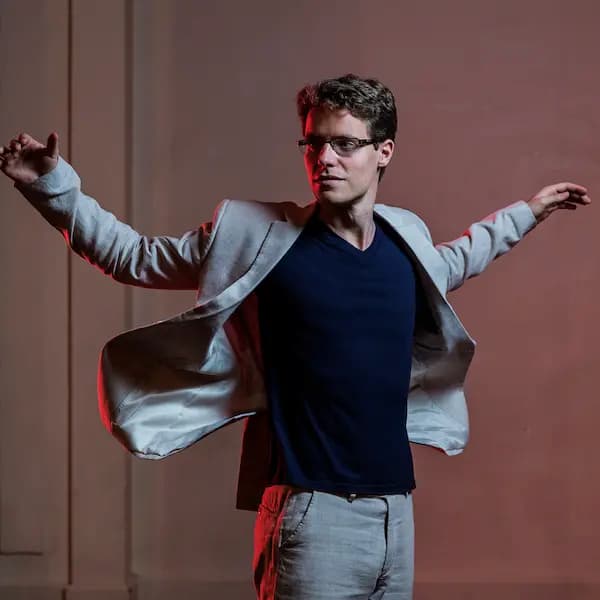
Florian Noack, 2019 (photo by William-Beaucardet)
Belgian pianist Florian Noack has taken transcription a different way. He was intrigued by looking at Bach’s Concerto for Four Harpsichords, BWV 1065, which was in itself a transcription of Vivaldi’s Concerto for Four Violins, RV 580. Bach assigned to the harpsichords the role of soloist that Vivaldi had given to the strings, reversing the roles of the instruments. Noack gave himself the challenge of now making a transcription for a single piano. The 40 fingers available to Bach’s harpsichordists is now reduced to just 10 fingers for Noack. In looking at what Bach did to Vivaldi’s music, showed him that ‘the same work can exist under several different identities’.
When he took up Rimsky-Korsakov’s Scheherazade, Noack was faced with reducing Rimsky-Korsakov’s dazzling and colourful orchestration that evoked the mysteries of the East with the sounds of a European piano. The Orient of Rimsky-Korsakov’s imagination was condensed by Noack but without losing either the distinct sound of the work or losing its story-telling qualities.

Sindbad and his ship, 2016 (illustration by Maria Surducan)
Noack uses the elements that made the pianoforte the ground-breaking innovation in music: the dynamics of loud (a roaring opening) and soft (the following rubato, pensive melody). As a soloist, he has the freedom to alter his tempos at will (something an orchestra cannot do, despite the conductor), and he uses that to bring out the vagaries of the sea and Sinbad’s voyage.
In the rest of the album, we have music from Tilman Susato and Bach to music for a Disney film. Noack opens the album with the Bach transcription we discussed above and follows that with Mendelssohn’s The First Walpurgis Night, Op. 60. Sheherazade follows. A Paraphrase on Various Waltzes by Johann Strauss II formed by the memory of the Vienna New Year’s Concerts and opens with an imagined waltzing figure on a music box coming to life. The 1551 Danserye of Tilman Susato follows, with three transcriptions. Sergei Prokofiev’s Classical Symphony No. 1 is brought to the keyboard, as is Shostakovich’s Waltz No. 2, originally written to accompany the 1956 Soviet film The First Echelon.
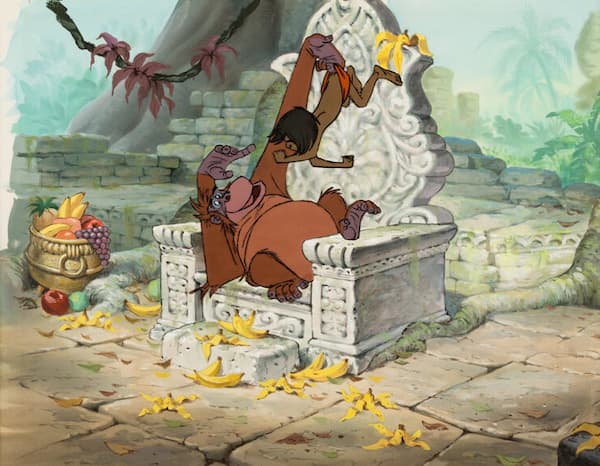
Disney: The Jungle Book: King Louie and Mowgli, 1967
Noack closes his album with a surprise, the Sherman Brothers’ song I Wanna Be Like You. Written for Louis Prima, the New Orleans trumpeter and entertainer, who provided the voice for the orangutan King Louie in Disney’s film The Jungle Book (1967), the song is full of New Orleans jazz styling; Noack’s transcription takes up the ‘complexity, polyrhythms, and idiom’ of the music and makes it his own.

Florian Noack: I Wanna Be Like You – The Piano Transcriptions
La Dolce Volta, LDV 121
Release date: 8 March 2024
Official Website
Music That Brings You Back Your Childhood Wonderland
by Fanny Po Sim Head , Interlude

© soshipuffs.wordpress.com
My job as a piano teacher has given me many opportunities to work with children. For the most part, I always have a wonderful time with them. Children are born without knowing any rules and boundaries, and their imagination can be limitless. Sometimes when I feel tired of being a responsible adult, I wish I could be a child again. While in reality, I cannot go back in time, listening to some children-inspired music can help to recall my childhood adventures and friends. I hope the following five compositions with children-related themes can also take you back to your childhood wonderland.
Children’s Carnival, Op.25 (1894) by Amy March Beach (1867-1944)
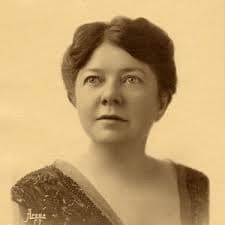
Amy Beach
Written by the American female composer Amy Beach, Children’s Carnival is a suite of six short pieces named after characters of early European music comedy pantomime. It begins with a fanfare-like promenade, followed by a lighthearted Columbine. The third piece is called Pantalon. In the comedy, Pantalon is Columbine’s father, characterized as an older man who always wears tight trousers and is always made fun of by other characters. Pierrot and Pierrette is the title of the fourth piece. These two characters, with whitened faces, usually wore white pantaloons and jackets with large buttons. Amy Beach had written a piece of delightful dance-like music for these two characters. The following piece is called Secret, which perhaps entails the secrets between Pierrot and Pierrette. Harlequin is the title of the last piece where the music displays his mischievous characteristic.
The Fantasy of Little C (2017) by Julie Kuok

Julie Kuok
The Fantasy of Little C is a set of ten piano pieces which form the story of a little boy named Little C. Julie Kuok, a well-known pianist and a famous piano instructor based in Hong Kong, wrote this suite for piano students at intermediate and advanced levels. Hong Kong is a melting pot between the east and the west, and the music of The Fantasy of Little C combines Western and Chinese compositional styles. Each piece has a descriptive title in both Chinese and English. The Chinese title of each work uses Chinese idioms starting with numbers 1 to 10 that connect all the pieces.
Adventures in a Perambulator (1914, rev. 1941) by John Alden Carpenter (1876-1951)
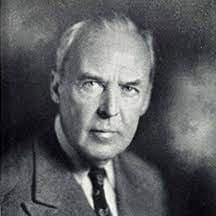
John Alden Carpenter
This is an orchestral suite written by American composer John Carpenter and was inspired by his daughter, Ginny. The program note reflects a baby’s perspective of the new world. It has six movements. The first movement, “En Voiture!” announces the adventures of a baby traveling in a carrier with her nurse after her second breakfast. She and her nurse meet “The Policeman,” listen to the music by “the Hurdy-Gurdy,” and pass by “The Lake.” She is excited by “The Dog.” In the nighttime, when she sleeps, she “Dreams” about the adventures she has every day.
Szesc Piosenek dziecinnych (Six Children’s Songs) by Witold Lutosławski (1913-1994)
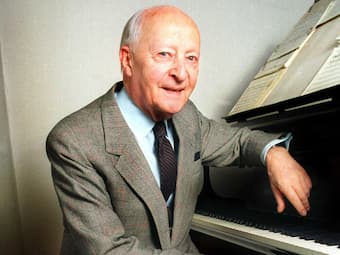
Witold Lutosławski
Polish composer and conductor Lutosławski was one of the most significant composers in Polish music history. His music is known for combining Polish folklore with contemporary writing styles. In addition to the Four Symphonies and Cello Concerto, (the best-known among his entire collection) this set of Six Children’s Songs is charming and worth listening to. Written in 1947 for voice and piano, it was later arranged for children’s choir and orchestra, as well as for mezzo-soprano and orchestra. Each piece has a descriptive title, and the music is fun and joyful, such as the third piece, Kitten, and the last piece, Bird Gossips.
Children’s Songs by Chick Corea (1941-2021)
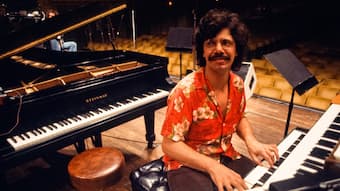
Chick Corea
If you are a jazz fan, you probably have heard of Chick Corea. Armando Anthony “Chick” Corea was a significant pioneer of jazz and jazz fusion who wrote and played jazz music throughout his career. However, his repertoire was not limited to jazz. The Children’s Songs is a set of twenty pieces written for the piano, (except the last one for violin, cello, and piano). Corea stated that he wanted “to convey simplicity as beauty, as represented in the Spirit of a child.” All Children’s Songs are short pieces with simple themes. Corea began writing these pieces in 1971 and completed them in 1980.
Ida Rubinstein: Dancer, Patroness, and Inspiration for Boléro
by Emily E. Hogstad
A gifted performer, she knew how to captivate audiences with her beauty, stage presence, and creative moxie.
Whether starring in controversial productions or commissioning classics like Ravel’s Boléro, Rubinstein’s influence extended far beyond the stage and continues to resonate even today.
Great Wealth and Great Tragedy
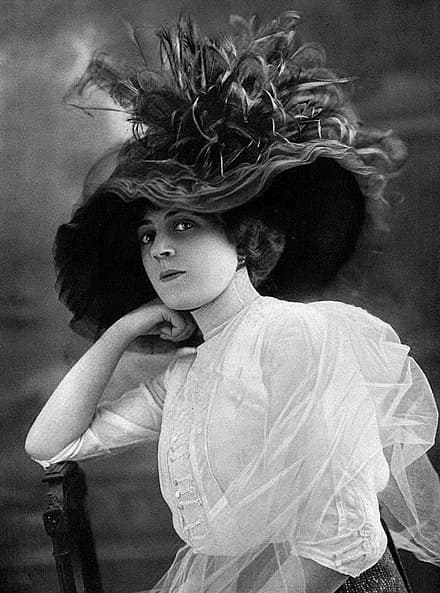
Ida Rubinstein, 1912
Ida Rubinstein was born in October 1885 in Kharkov in present-day Ukraine, the youngest of the four children of Lev Rubinstein and his wife Ernestina.
The Rubinsteins were a hugely wealthy family, overseeing mills, breweries, and banks.
However, their extraordinary wealth couldn’t insulate them from tragedy. Ernestina died in 1888, then Lev died in 1892, possibly of cholera.
After their parents’ deaths, the Rubinstein children were split up. Ida and her sister Irène were relocated to St. Petersburg to live with an aunt.
She received a wide-ranging education that focused heavily on the arts and languages. The arts and arts philanthropy were hugely important to the entire family. (In fact, her cousin Iosif studied piano under Liszt.)
Finding Her Way to the Stage
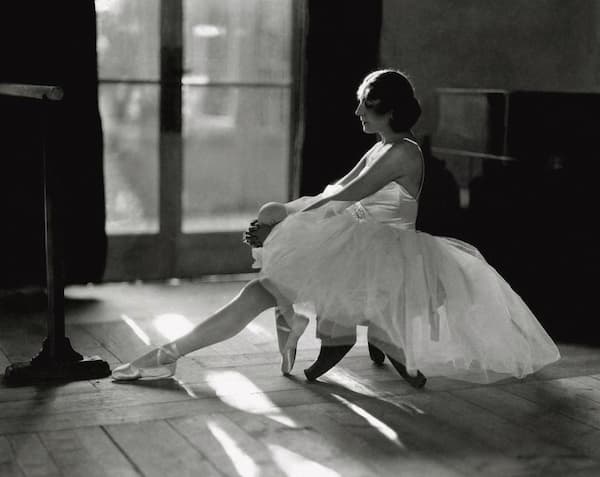
Ida Rubinstein in tutu
As a young woman, faced with the prospect of entering the marriage market, she decided she wanted to pursue a life on the stage instead.
She studied theater for a few years in both Moscow and St. Petersburg.
In 1904, when she was just nineteen, she mounted and starred in a production of Sophocles’s Antigone, casting herself in the title role.
She hired painter and costume designer Léon Bakst for the project. He told her to start her career small and smart: to only present one act, and to do so privately.
The advice was sound. Her private performance was a major success, and Rubinstein proved to be incredibly talented and magnetic.
She also, fatefully, began studying dance. Despite her relatively advanced age, dance quickly became her major passion.
She had begun too late to become a great technician – or even a good one – but her charisma, grace, beauty, and stage presence made up for it.
Bringing a Controversial Salome to Life
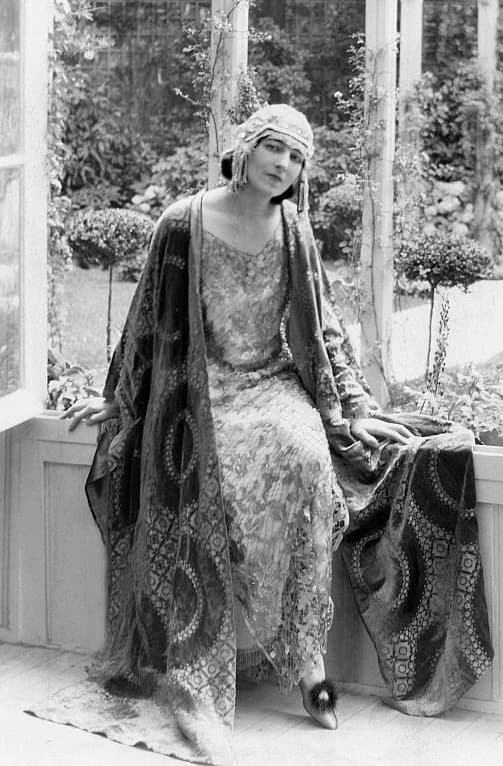
Ida Rubinstein, 1922
In 1908, she caused a succès de scandale in St. Petersburg, when she appeared in an adaptation of Oscar Wilde’s Salome.
The performance was banned by the Orthodox Church, the official state censor. The performers got around that by miming the entire performance.
The role offered her the opportunity to dance the highlight of the show: the Dance of the Seven Veils, performed to newly composed music by Alexander Glazunov. Her choreographer for the number was Michel Fokine, famous for choreographing The Dying Swan, Les Sylphides, Scheherazade, The Firebird, and countless other classics.
Alexander Glazunov: “Dance of Salome” op.90
One contemporary described her gamble:
Never before had the St. Petersburg public been treated to the spectacle of a young society woman dancing voluptuously to insinuating oriental music (composed by Glazunov), discarding brilliantly colored veils one by one until only a wisp of dark green chiffon remained knotted round her loins. Although, as Alexandre Benois revealed, this final and reprehensible moment of the dance was dissimulated by means of a lighting trick.
Not surprisingly, her family was horrified and desperately wanted to rein her in. To ensure that none of them would have the power to take legal action against her, she married a cousin named Vladimir Gorvits.
Joining Forces with Diaghilev

Ida Rubinstein in Le Martyre de saint Sébastien, 1911
Choreographer Serge Diaghilev of the legendary Ballets Russes took notice of the striking young socialite with the penchant for nudity.
He cast her in the new ballet Cléopâtre, a work choreographed by Fokine and featuring music by Anton Arensky. She traveled to Paris and donned the see-through costume with great enthusiasm.
Anton Arensky: Egyptian Nights
Despite her lack of training, she enthralled enchanted audiences.
She returned in the 1910 season in a ballet made up of music from Nikolai Rimsky-Korsakov’s 1888 symphonic suite Scheherazade.
That success was even greater than Cléopâtre had been, and it altered the course of music, design, and fashion for years to come.
Striking Out on Her Own
Rubinstein could have continued with the Ballet Russes, but chose not to so that she could pursue her own projects.
Diaghilev became irritated with her. She had seemingly endless amounts of money at her disposal and could hire his greatest artists out from under him. He remained bitter about their relationship until his death.
After leaving the Ballet Russes, Rubinstein branched out on her own to produce the wildly ambitious Le Martyre de saint Sébastien.
This was a musical mystery play that she commissioned and produced, featuring a text by Italian poet Gabriele D’Annunzio and incidental music by Claude Debussy. Fokine returned to choreograph.
Conductor Michael Tilson Thomas describes Le Martyre de saint Sébastien
Rubinstein gender-bent the role, appearing as an androgynous St. Sebastian. Not surprisingly, that casting caused dismay among conservative factions. In fact, the archbishop of Paris warned potential Catholic theatergoers not to attend because she was both Jewish and a woman.
Unfortunately, the five-hour-long project was rushed, resulting in a lack of narrative cohesiveness, and despite her best wishes and the geniuses attached to the project, Le Martyre was not a success.
In 1928, she established her own ballet company, Les Ballets Ida Rubinstein. She would commission important works over the following years from a variety of composers.
Igor Stravinsky’s “Le baiser de la fée”
In 1928, she commissioned Stravinsky to write a ballet using Tchaikovsky’s music. The result was “Le baiser de la fée.”
Stravinsky: “Le baiser de la fée”
Stravinsky wrote to a friend whom he sent the piano score to:
Don’t show it to Ida, Nijinsky or Benois. It is necessary for people such as they are – not particularly initiated – that I play the music for them myself.
Diaghilev was deeply upset with Stravinsky for having accepted a commission from Rubinstein after he’d pulled back from Diaghilev.
“He would not forgive me for having accepted Ida Rubinstein’s commission, and he was loud, both privately and in print, in denunciations of the ballet and of me,” Stravinsky wrote later.
Stravinsky conducted the premiere at the Paris Opéra in 1928. Rubinstein only arranged for a single performance, to Stravinsky’s irritation: he was bewildered that anyone would spend thousands of dollars on such a venture. “Nobody in the artistic world is as mysteriously stupid as this lady.”
Despite his misgivings, her money talked. He reunited with her for 1934’s Perséphone, a work for speaker, singers, dancers, and orchestra.
Maurice Ravel’s “Boléro”
In 1927, Rubinstein approached Maurice Ravel about creating a work for her.
He had his heart set on arranging some Spanish dances by Albéniz’s Iberia. However, he found out that another composer had the rights to the music, and that his project would be impossible to carry out. He complained, “The laws are idiotic. What am I going to tell Ida?”
He came back with what would become one of the most popular pieces in classical music history: the fifteen-minute long Boléro.
She negotiated exclusive rights to Boléro for three years in theaters and one year in concert halls.
Ravel: Boléro | Alondra de la Parra | WDR Symphony Orchestra
At the same time, she resurrected Ravel’s orchestral tone poem La Valse, which Diaghilev had famously dismissed as “a masterpiece” but “not a ballet. It’s a portrait of ballet.” (This remark soured the formerly fruitful relationship between Ravel and Diaghilev once and for all.)
Ida Rubinstein disagreed with Diaghilev, and hired Bronislava Nijinska to choreograph it. In the late 1920s, she successfully presented Boléro and La Valse on the same program.
La Valse – Corps de ballet (The Royal Ballet)
In 1932, Ravel was in a terrible taxi accident that left him with brain damage. It became increasingly difficult for him to compose and even to go about his daily life. Ida paid for a trip for him and a friend to visit Spain and Algiers, hoping it would improve his health.
The Legacy of Ida Rubinstein
In addition to her incredible contributions to the repertoire, it’s worth noting Ida Rubinstein’s famous free spirit.
She was always impeccably dressed in the latest fashions. She had romantic relationships with both men and women. She loved going on big game hunts and even living amongst wild cats. For a while, she kept a leopard cub and even a panther in her apartment. The panther once came close to attacking Diaghilev. He was bitter about that.
Ida Rubinstein retired to the south of France in the 1930s and died in 1960.
Historical opinion on her is mixed.
On one hand, it is believed that she was self-indulgent and perhaps a little too eccentric for her own good.
Simultaneously, no one can deny the number of masterpieces that she ushered into the world. Few wealthy people in the history of classical music have used their resources to bring so much musical joy to so many people.
20 Facts About Classical Music
by Emily E. Hogstad, Interlude
Today we’re looking at twenty facts about classical music that will give you an overview of what classical music is, its extensive history, its most famous practitioners, and more.

© Musicnotes, Inc.
Let’s get started:
1. It’s really hard to define classical music – so much so that sometimes it’s defined by what it’s not.
Wikipedia defines classical music as “generally [referring] to the art music of the Western world, considered to be distinct from Western folk music or popular music traditions.”
That said, although classical music is separate from folk music or pop music, it has often been influenced by both of those traditions.
2. Classical music has existed in one form or another for over a thousand years.
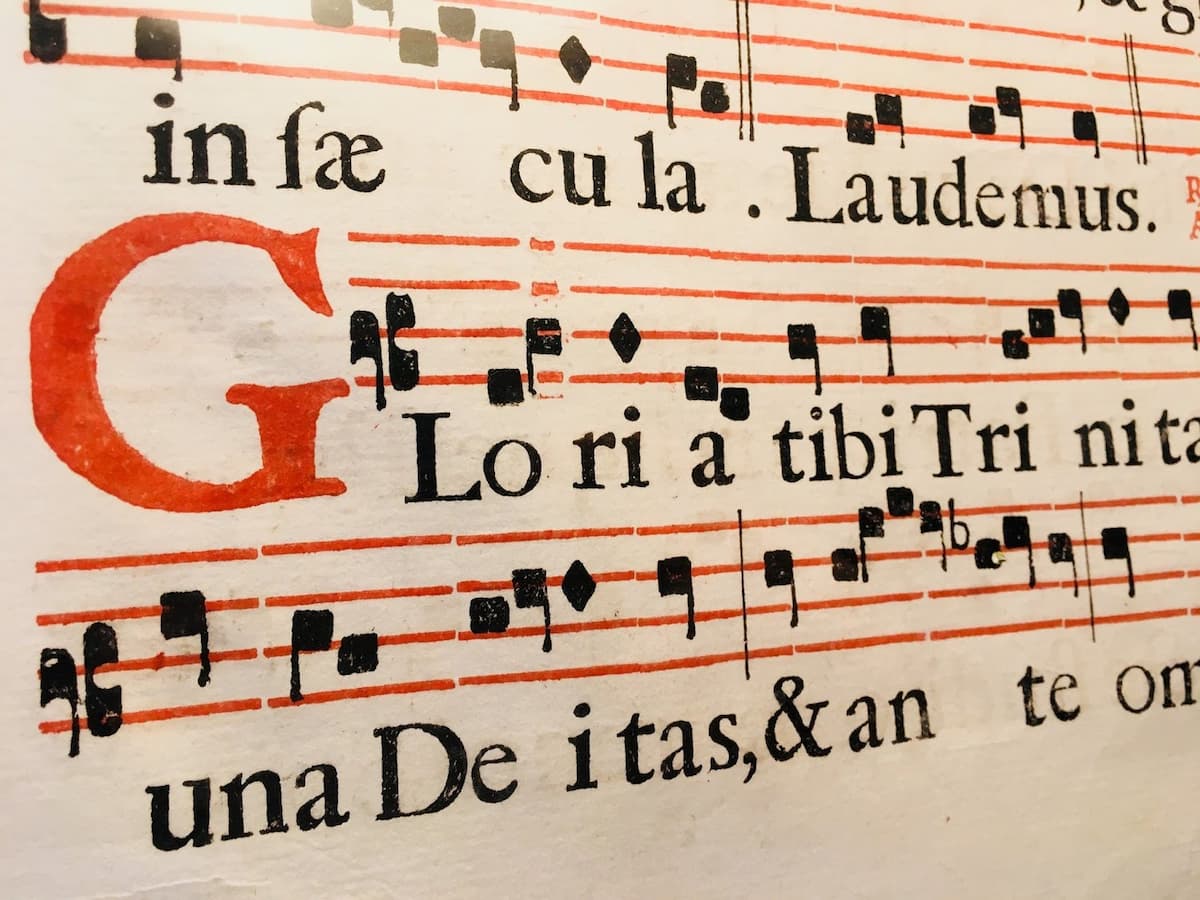
Gregorian chant
One reason why it’s so hard to define classical music with precision? The phrase can mean anything from Gregorian chants from a thousand years ago to elegant string quartets from the 1700s to spiky percussion solos from the present day.
The good news is that such an extraordinary range means that most people can find something within the genre that they really enjoy listening to.
3. There are dozens of groupings of classical musicians.
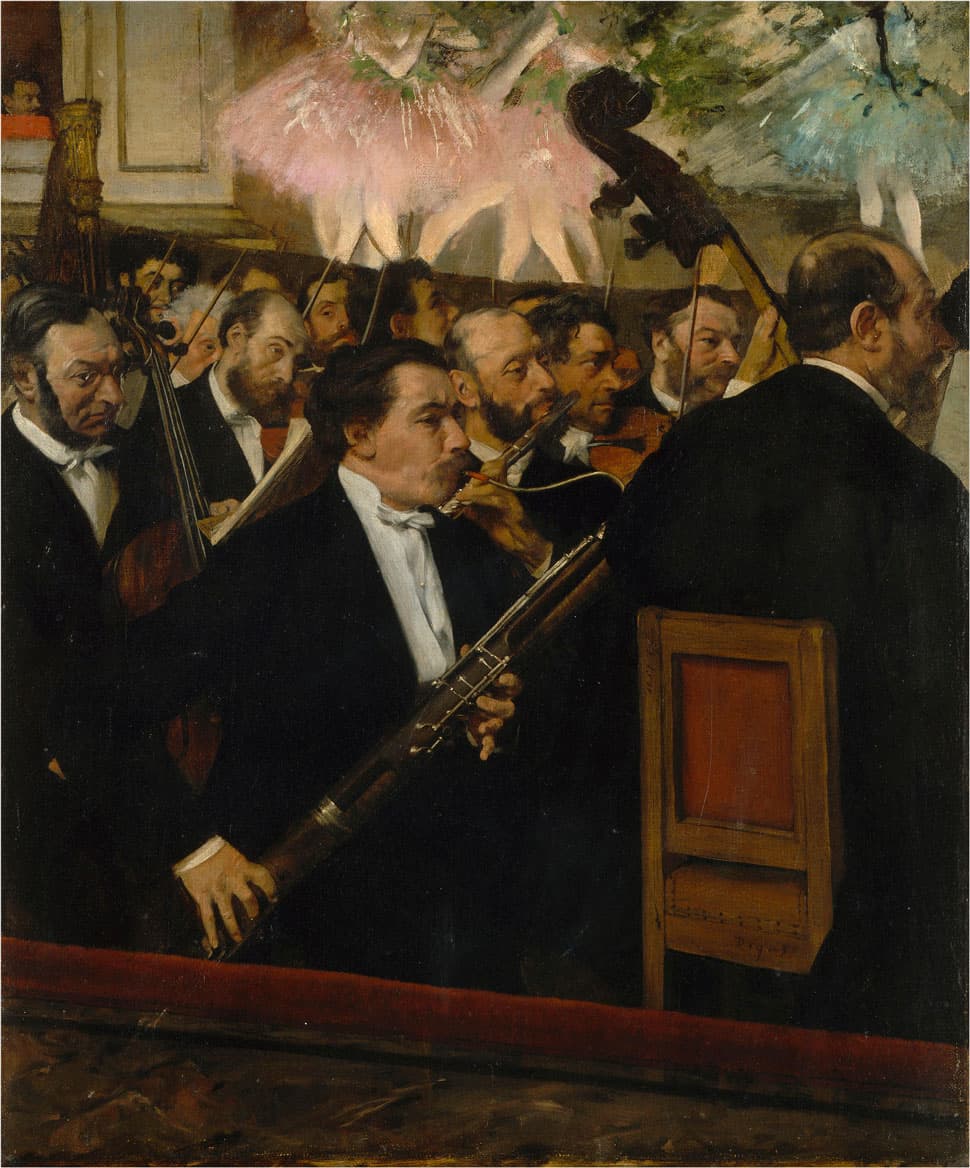
Edgar Degas: The Orchestra at the Opera
There are dozens of combinations of classical musicians, but here are some of the most popular:
- Symphony orchestra: a group of between fifty to a hundred musicians including violins, violas, cellos, basses, clarinets, flutes, oboes, French horns, trumpets, trombones, and a full percussion section
- Chamber orchestra: a smaller group of around fifteen to fifty musicians including most of the instruments above
- String quartet: two violins, a viola, and a cello
- Piano trio: one piano, one violin, one cello
- Piano quartet: one piano, one violin, one viola, one cello (usually)
4. Classical music grew out of church music.
The Christian church was an extremely powerful force in Europe for centuries.
To express its wealth and political and social power, as well as to increase the impact of worship services, the church hired musicians to compose and perform music.
In this way, the church provided countless creative and economic opportunities for musicians and artists.
5. There are at least six main eras in classical music history. (Some scholars believe there are more.)
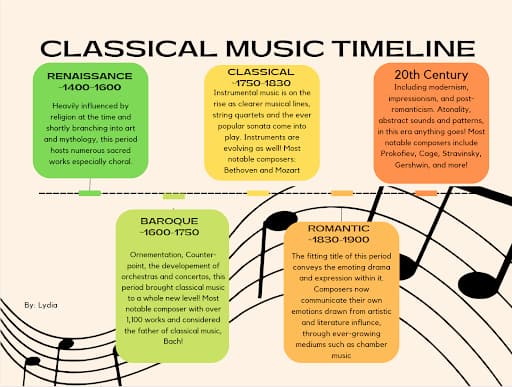
© pixeljournal.org
Here’s a quick summary of the six best-known eras in classical music history. The dates are approximate.
a. The years from before 1400 are known as the Medieval era in music. The medieval era includes Gregorian chants and music and, thanks to newly standardized notation, music with increasingly complicated intertwining lines and rhythms. Famous composers from this era include Hildegard of Bingen, Machaut, and Pérotin.
b. The years between 1400 and 1600 are known as the Renaissance era in music. The Renaissance era includes madrigals, chansons, and motets, among other forms. Compositional rules hardened during this era, and religious and secular music began influencing each other. Famous composers from this era include Ockeghem and Palestrina.
c. The years between 1600 and 1750 are known as the Baroque era in music. This was the era in which many types of music developed into forms that are recognizable to modern-day musicians, such as sonatas, concertos, operas, and cantatas. Famous composers from this era include Monteverdi, Bach, Handel, Vivaldi, and Telemann.
d. The years between 1750 and 1820 are known as the Classical era in music history. Composers during this era subscribed to Enlightenment ideals and valued elegance, clarity, balance, and naturalness. However, instrument technology advances also made wider spectrums of volume possible, which also led to a subgenre known as the Sturm und Drang (Storm and Stress) style to develop. Famous composers from this era include Mozart, Haydn, Schubert, and Beethoven.
e. The years between 1820 and 1910 are known as the Romantic era in music. Composers in this era loved to explore drama, instrumental color, natural inspirations, nationalism, and emotional extremes. Famous composers from this era include Liszt, Tchaikovsky, Strauss, Schumann, Berlioz, Dvořák, Wagner, Mahler, Sibelius, and many others.
f. The years between 1910 until around mid-century are known as the Modern era. (Sometimes another era is recognized as postmodernism, but people disagree as to how to classify twentieth century music.) Modern music is known for its individualism and experimentation. Famous composers from the twentieth century include Prokofiev, Stravinsky, Shostakovich, Gershwin, Bernstein, Barber, Ives, Messiaen, and others.
6. The recipes for various types of classical music developed during the Baroque era.
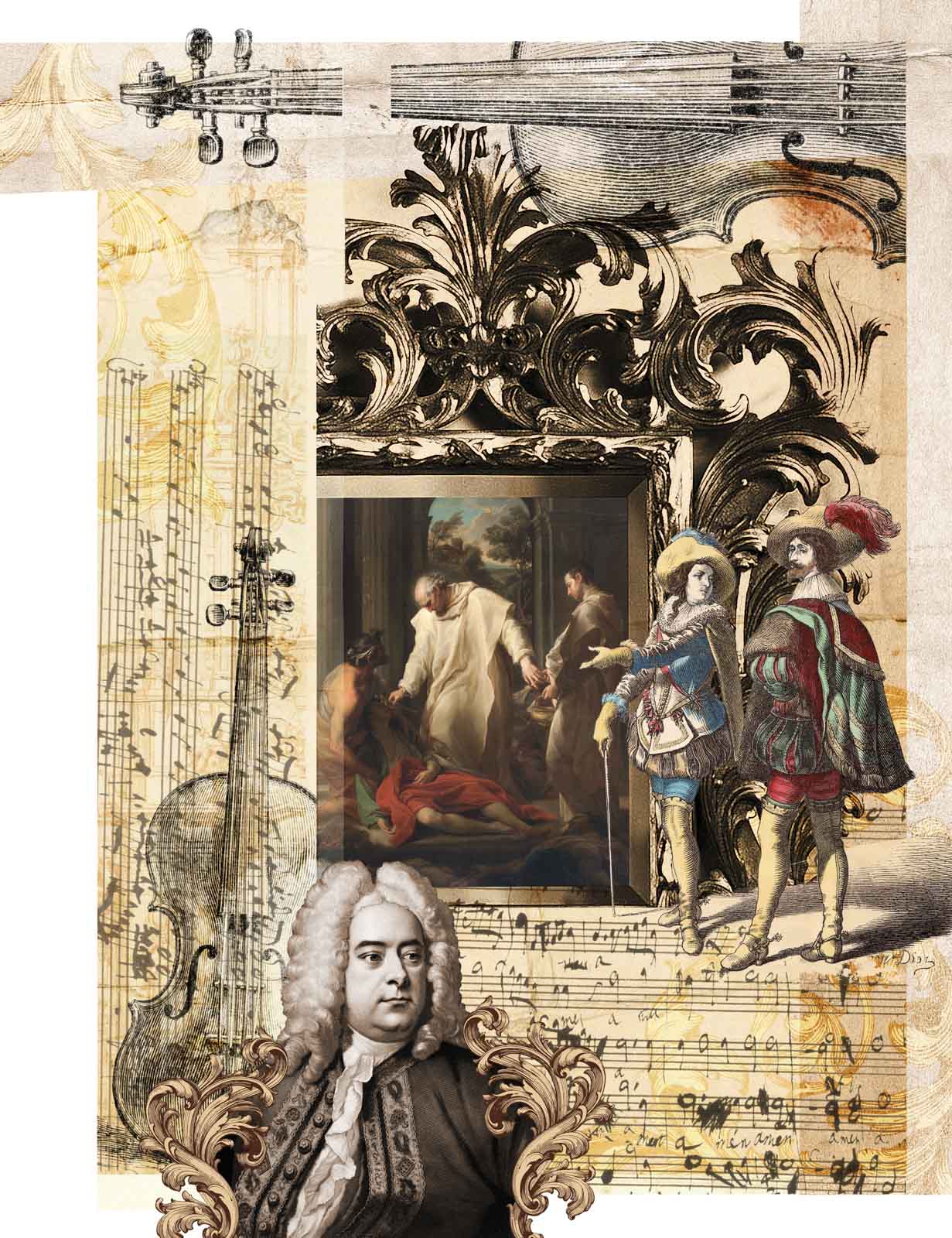
Collage of music and arts in the Baroque period by Stephen Louis © Cathay Pacific
Classical music is full of different types of music that follow a specific structure, many of which became standardized during the Baroque era.
For instance, during the Baroque era, a concerto gained specific traits. A concerto is now understood to be…
- a work for a solo instrument or instruments.
- split into three parts, called movements.
- made of different musical material in each movement.
- three movements long, with the first faster, the second slower, and the final faster again.
To this day, many concertos follow this same basic recipe.
7. The word opus and a number refers to the order in which a composer’s work was published.
We wrote an article about “How music is catalogued”
An excerpt:
To help identify and organise pieces of music by a particular composer, individual compositions or sets of works are usually given an “Opus” number. The word “opus” is Latin and means “work” or “work of art”, often abbreviated as “Op.”, or “Opp.” in the plural. The practice of assigning an “opus number” to a work or set of works when the work or set was published began in the seventeenth century. Opus numbers were not usually used in chronological order and did not necessarily denote when a work was actually composed. Unpublished works often were left without opus numbers.
8. People who play classical music are almost always taught by individual teachers, as opposed to self-taught.
In the classical music world, instrumental technique – which has been refined over hundreds of years – is very important.
Without careful oversight by a teacher, it is easy to injure yourself while playing music…or just not be able to make progress past a certain point.
In other musical traditions, the passing along of knowledge is often less formalised and more organic.
9. Classical musicians used to improvise much more than they do now.
Wolfgang Amadeus Mozart and Ludwig van Beethoven were not just famous composers; they were famous improvisers, too.
However, as instrumental technique advanced and became increasingly demanding to learn, and as musicians were encouraged to choose a specialty between composing and performing soloist, their comfort levels with improvisation dropped.
By the middle of the twentieth century, the tradition of improvisation in classical music had largely died out.
However, there have been efforts to revive it in the modern day.
10. Classical composers have often taken inspiration from folk music.
Nationalism was very important to classical composers and musicians, especially in the nineteenth century after the French Revolution, the rise of Napoleon, and the political turbulence that happened afterwards.
Especially in occupied countries, composers from classical music history used folk music to provide colour to their music.
Jean Sibelius wrote Finnish folk music into his compositions. Franz Liszt was inspired by the music of Hungary. Antonín Dvořák was inspired by Czech and Bohemian influences. There were many other similar examples.
11. Wolfgang Amadeus Mozart was one of the most astonishing child prodigies of all time.
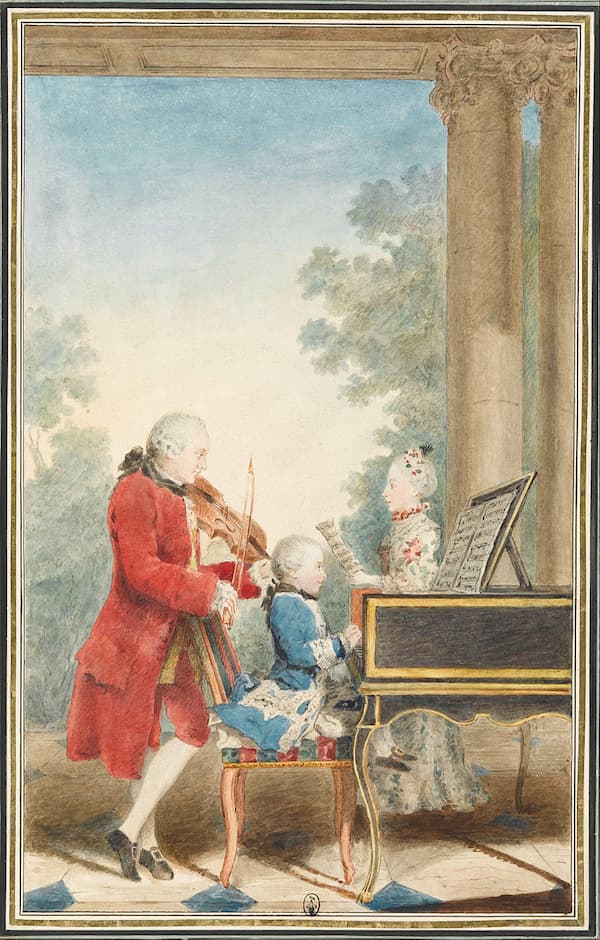
Louis Carrogis Carmontelle: Mozart family on tour: Leopold, Wolfgang, Nannerl, ca 1763
Wolfgang Amadeus Mozart was born to a professional musician and his wife in 1756.
He had an older sister named Maria Anna Mozart who was also a child prodigy, and as a toddler he watched her lessons. Soon, inspired by his older sister, he began learning instruments himself.
By five, Wolfgang was composing keyboard music. By eight, he’d written his first symphony.
In 1762, the Mozart family went on the road to showcase their precocious children and make money, and the rest is history!
12. Ludwig van Beethoven lost his hearing but still kept composing.

Joseph Willibrord Mähler: Beethoven, 1804–1905 (Gesellschaft der Musikfreunde in Wien)
Ludwig van Beethoven first realised he had hearing issues in the 1790s, when he was in his mid-twenties.
The following years were torturous for him healthwise. He didn’t just go deaf; first, he dealt with long periods of tinnitus.
Between the tinnitus and his fear of what such a disability would mean for his ability to support himself, he entertained ideas of suicide.
By his mid-forties, he was completely deaf and could only communicate with friends and family by writing out his conversations. However, he could still hear things in his mind, and he continued composing.
13. Violinist Niccolò Paganini and pianist Franz Liszt set new standards of virtuosity.
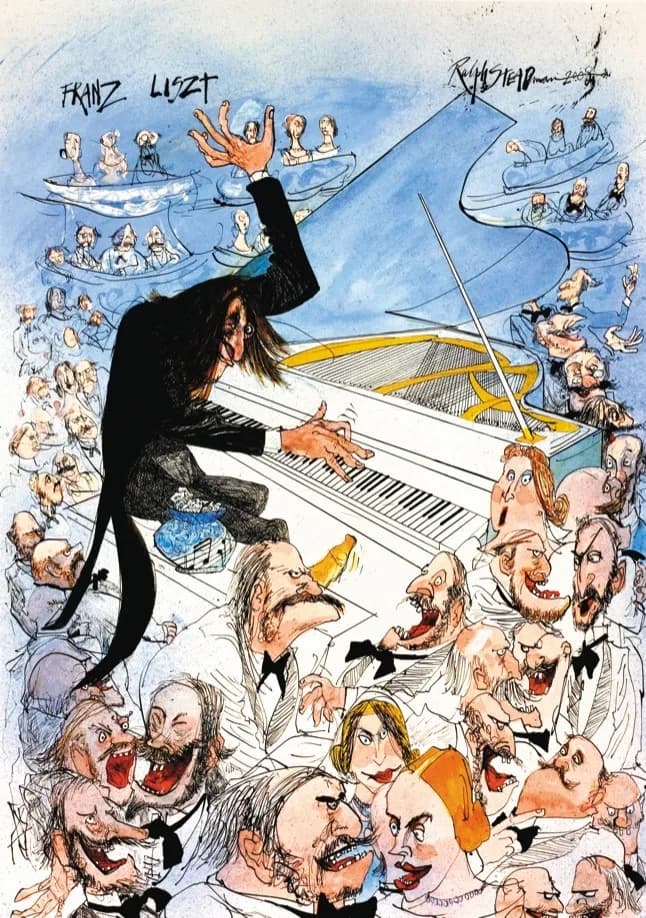
Liszt concert by Ralph Steadman
Violinist Niccolò Paganini (born in 1782) and pianist Franz Liszt (born in 1811) each set new standards for virtuosity on their respective instruments and helped to kickstart a new era of technically dazzling performances.
It is believed nowadays that Paganini may have had a health issue like Marfan’s Syndrome or Ehlers-Danlos Syndrome. His joints were extra flexible, which opened new doors for instrumental technique. He was also very pale, gaunt, and cadaver-like. Rumours spread about his apparently supernatural abilities, and rumours flew that he’d made a deal with the devil.
Franz Liszt also made a splash with his audiences, so much so that a medical term was created for the specific hysteria that his presence unleashed: Lisztomania. His fans went so far as to save the butts of his cigarettes.
These two figures were some of the first instrument-playing idols. Their fame helped to create the archetypes of the twentieth-century rock ‘n’ roll lifestyle.
14. Romantic era composer Robert Schumann fell in love with great pianist Clara Wieck. They got married…after protests from her father.
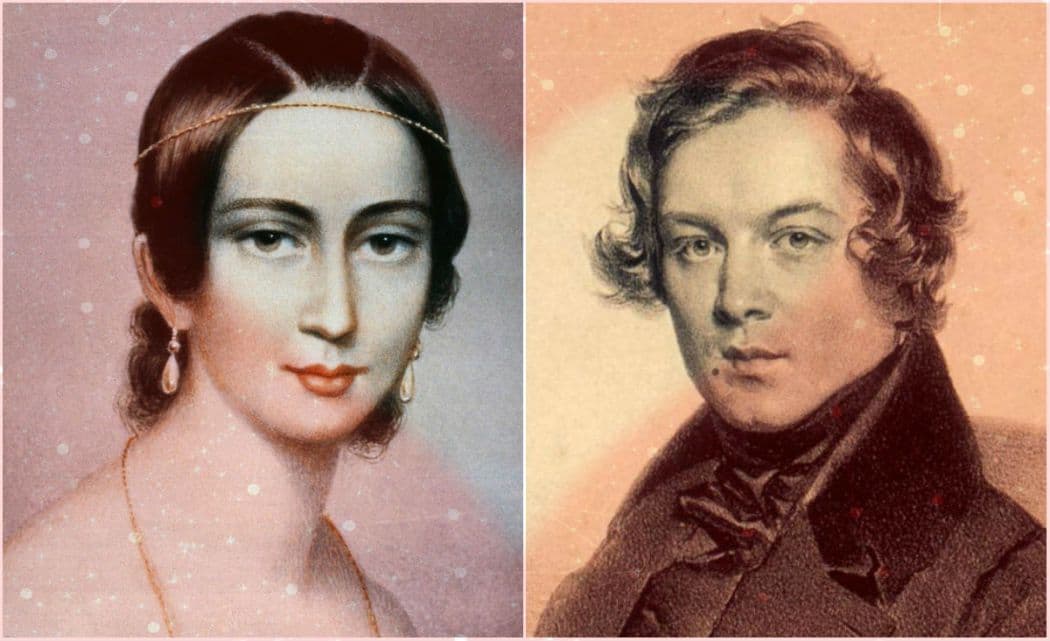
Robert and Clara Schumann
Many people vaguely remember the name Robert Schumann from their music education classes. They may also remember that his wife’s father tried to keep him and his wife from getting married and that the whole family went to court to resolve the issues.
However, it’s not often explained how Clara Wieck Schumann was one of the greatest pianists of the century. She had a decades-long career and made sure that her husband’s work entered the canon.
15. Composer Richard Wagner took opera to an extreme with his Ring Cycle.

Richard Wagner, 1876
Composer Richard Wagner embraced the idea of the “Gesamtkunstwerk”, or “total work of art.”
In such a work, music, visuals, and script would all work together in harmony.
Wagner’s crowning achievement was a set of four massive operas, known collectively as The Ring Cycle. When the operas that make up the Ring Cycle are played one after another, they last for fifteen hours: the equivalent of two seasons of a one-writer prestige TV show.
16. Composer Gustav Mahler wrote symphonies on a mammoth scale.
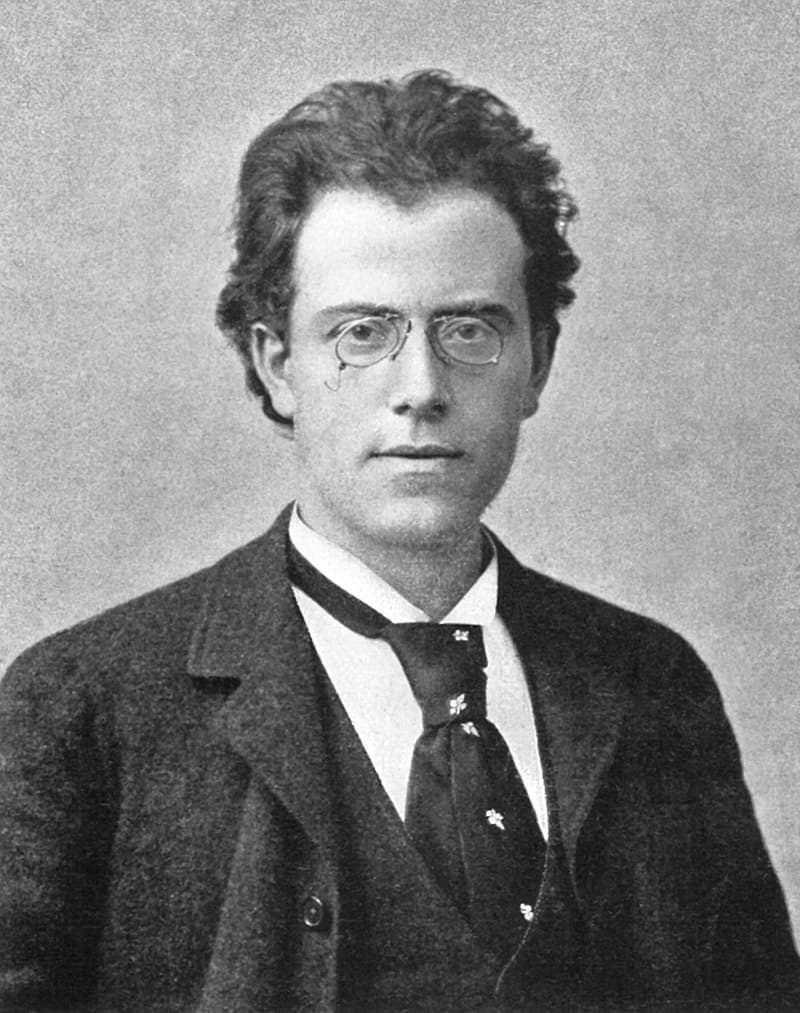
Gustav Mahler, 1892
Gustav Mahler’s third symphony lasts for ninety minutes.
His eighth symphony is written for up to a thousand performers, including multiple choirs. Hence its nickname, Symphony of a Thousand.
17. Classical music has been famously used in cartoons.
We’ve written a variety of articles about the use of classical music in cartoons. In this one, we looked at how the animators incorporated classical music into Bugs Bunny cartoons.
In the classical music realm, nothing tops Warner Bros.’ take on Wagner in What’s Opera, Doc? This 1957 cartoon used music from all 4 of the Ring operas, Tannhäuser, Rienzi, and The Flying Dutchman to create the immortal story of Elmer Fudd hunting, as usual, Bugs Bunny.
18. Classical music probably doesn’t make your kids smarter.
In 1993 a famous study was published in Nature, claiming that college-aged subjects in experiments improved their performance on spatial tasks after listening to classical music. This helped lead to a cultural conversation about “the Mozart effect.”
Later experiments tried to replicate the results with children, but were unsuccessful.
19. Classical music can help you relax.

© health.clevelandclinic.org
If you can find classical music that keeps a steady volume and beat, has pleasant harmonies, and features no lyrics, that music might lower the stress hormone cortisol and lower your blood pressure, according to studies.
20. Composers are still writing new music in the classical music tradition today.
Classical composers are still active today! Many are women and people of colour, defying the preconceived notion that a composer has to be a dead white man.
Here are a few modern composers to check out:
- Caroline Shaw
- Jessie Montgomery
- Max Richter
- Missy Mazzoli
- Wynton Marsalis
There are so many more, too! Remember, classical music isn’t only written by dead white guys in powdered wigs.
We hope you’ve enjoyed these classical music facts! The genre is massive and features a wide variety of types of music. Chances are you’ll eventually find something you’ll love listening to!